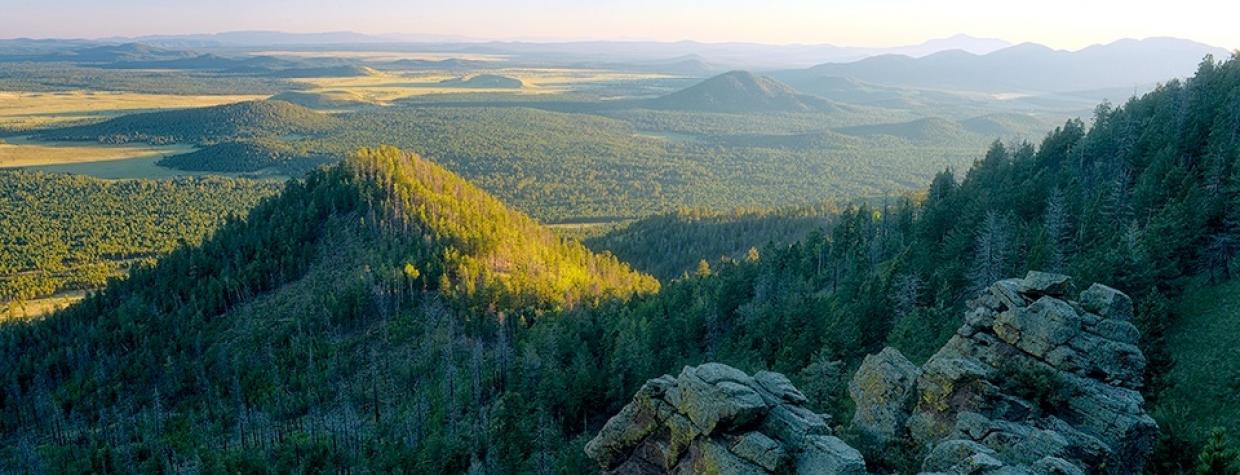Kaibab National Forest, Flagstaff
On May 24, 2000, Mother Nature tossed a bolt of lightning at a ponderosa pine on the southwest side of Kendrick Peak. That was the first tree to go in the Pumpkin Fire, which ultimately wiped out 14,760 acres on and around the mountain. The north side was hit the hardest, but the east and west got it pretty good, too. On the south side, where the Kendrick Trail climbs to the mountain’s summit, the fire burned in a more gentle mosaic pattern, leaving patches of burned and unburned woodland. Although you’ll see signs of the blaze on this trail, it’s not overwhelming.
The trail begins as a wide dirt path surrounded by ponderosas. The ascent is immediate, and within a few minutes you’ll arrive at a small grove of young ponderosas. They’ve taken root in the wake of the fire, and they’re the first of many signs of recovery. Although it’s gut-wrenching to think about what’s been lost, what’s happening along the Kendrick Trail offers hope. Still, it’ll be decades before the trees re-establish a canopy. Meanwhile, the holes in the ceiling are allowing for new growth — ferns, flowers and grasses — that attracts elk and mule deer, as well as big cats and black bears.
On the horizon, above and beyond the young ponderosas, you’ll see the Kendrick Lookout Tower. It’s a landmark that appears on and off during the hike. Although man-made structures have a way of sullying a panorama, this one, at least, offers a look at where you’re going — and where you’ve been, once you make it back down.
Moving on, you’ll pass a large wall of volcanic rock and arrive at the Kendrick Mountain Wilderness, a 6,510-acre sanctuary that’s managed by Mother Nature. Just inside the boundary, the trail climbs to a place that escaped the fire. Five minutes later, however, it moves back into the recovery zone. That’s the pattern of a mosaic fire.
At the half-hour mark, the San Francisco Peaks make an appearance to the east. It’s a photo op that’s followed by the trail’s first Engelmann spruce. From there, the hike begins a series of long but gradual switchbacks. Between the first zig and the subsequent zag, you’ll come to the most impressive tree of the day. It’s a stumpy old ponderosa that survived the Pumpkin Fire, along with many other hardships over the last two centuries.
Continuing uphill, the trail arrives at a level spot. It only lasts for about 30 yards, but the respite is welcome. As soon as you start climbing again, you’ll see the growing collection of wind turbines on the plateau to the west, and then a big aspen, which serves as gatekeeper for a grove of old trees that dodged the fire. Beyond the survivors, the switchbacks enter a brief thicket — rare on this trail — and cross a rocky slope. Ferns are the dominant plant species along this stretch.
A few switchbacks later, the trail moves into a subalpine forest of Douglas firs, white firs, Engelmann spruce and aspens. The south side of the trail is still steep, and impressive, but it’s the trees that steal the show during the final ascent to the upper saddle, an idyllic place that’s home to the Kendrick Lookout Cabin. The structure, which was built in 1917, is listed on the National Register of Historic Places.
The rest of the route is a short series of switchbacks that lead to the tower. In the summer, you can climb the 10-step ladder and say hello. Otherwise, there’s an adjacent helipad that makes a good place to eat Goldfish, take a nap or just look around. From the top, you’ll get clear views of the San Francisco Peaks to the east, Oak Creek Canyon to the south and the North Rim of the Grand Canyon to the north. You’ll also see the worst effects of the Pumpkin Fire, along with its origin to the southwest. What you won’t see is the ponderosa pine that was struck by lightning on May 24. However, you can rest assured that Mother Nature is working on a worthy replacement.
Length: 8 miles round-trip
Difficulty: Moderate
Elevation: 8,000 to 10,418 feet
Trailhead GPS: N 35˚23.214’, W 111˚52.056’
Directions: From Flagstaff, go northwest on U.S. Route 180 for 17.2 miles to Forest Road 193. Turn left onto FR 193 and continue 3.2 miles to Forest Road 171. Turn right onto FR 171 and continue 2 miles to Forest Road 190. Turn right onto FR 190 and continue 0.4 miles to the trailhead.
Vehicle Requirements: None
Dogs Allowed: Yes (on a leash)
Horses Allowed: Yes
USGS Maps: Kendrick Peak, Moritz Ridge
Information: Williams Ranger District, 928-635-5600 or www.fs.usda.gov/kaibab

